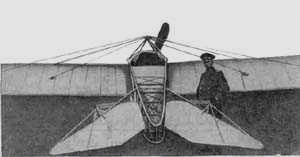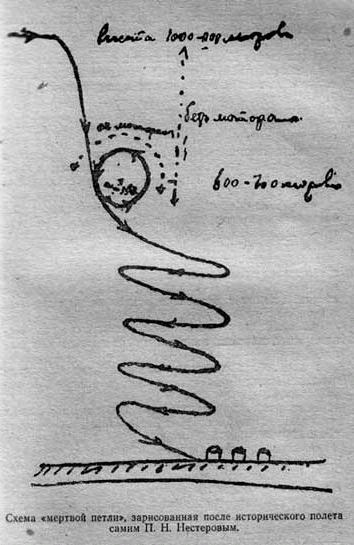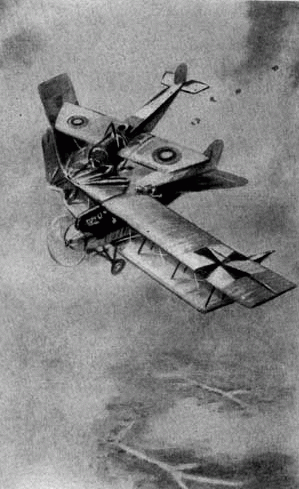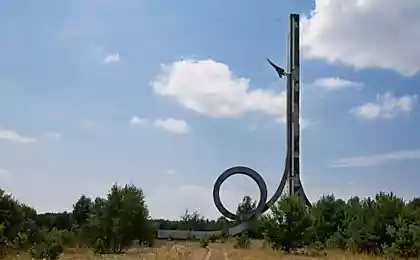1868
Loop Nesterov
September 9, 1913 Russian pilot Pyotr Nesterov, controlling aircraft "Nieuport-4", the world's first performed aerobatics - "dead loop" ("loop Nesterov»).

Pyotr Nesterov was born in the city of Nizhny Novgorod February 27 (February 15, Old Style), 1887 in family education officer cadet corps. After the sudden death of his father family's financial situation has deteriorated. His mother, Margarita V., without the means to pay for housing, was forced to move with their four children in the Widow's house. In 1906, after the successful completion of the Mikhailovsky Artillery School, he served in Vladivostok, where he personally developed rules adjust fire from the balloon.
In 1910, do not possess good health Pyotr Nikolayevich ill and was transferred to the Caucasus back Artillery Brigade "climatic conditions for a period of one year." Vladikavkaz Nesterov met with Artem Katsanom, pilot - aviator who built a glider of his own design. "My passion for aviation started in 1910 ... - later recalled PN Nesterov. - I set myself the task to build such a device, a move that would be the least dependent on the environment and almost entirely subordinated to the will of the pilot ».
October 7, 1911 Nesterov arrives in St. Petersburg officer aeronautical school. At the same time he was assigned to the aviation department of the same school. For 11 months, relying on training, Nesterov managed to achieve a lot. Man looking for a patriot who sincerely cares for the success of the domestic aviation, he was not satisfied with the modern methods of piloting. Nesterovskoye idea of turning an airplane with a roll, not to mention his statements that the aircraft can do in the air "dead loop", not only designers, but also comrades considered folly. This inertia and conservatism could win only in practice.

Even in the period of study, 18 August 1912, Nesterov took a 13-hour training flight in a balloon, flying 750 miles. Flight took place at an altitude of 3400 meters. It was a major achievement of Russian aeronautics. His first solo flight in an airplane Nesterov undertook 12 September of the same in 1912. After 16 days, he successfully passed the examination for the pilot - aviator, and more in a week - the title of a military pilot. As a part of aviation detachment Nesterov was transferred from St. Petersburg to Warsaw, where in November 1912 began training sorties in combat "Nieuport" and established himself as a pilot - the experimenter. For example, during one of the flights he gained altitude of 1600 meters (which already was an achievement), and turned off the engine, circles, eights planned over Warsaw than "comrades brought in awe».
Old canons piloting repeatedly violated them. Nesterovskaya planning system turned off the engine and exceptional composure helped him January 25, 1913 to avoid death, when during a routine flight on fire gasoline in the carburetor and the engine stopped. This is most clearly proved pilots and commanding superiority of the new method of control plane. His first-ever survey technique maneuvering monoplane in the horizontal plane, in the implementation of research bends made mute doubts of skeptics. And it's the first recognition. In the characterization of January 1913 stated: "Peter Nesterov: Pilot outstanding. Technically prepared perfectly. Energetic and disciplined. Moral qualities are very good ».

On the basis of studying the flight of birds, he has developed a draft of the original aircraft without the vertical fin. Military authority to reject the project, but persistent designer continued to improve his car. In the summer of 1913, the project was approved, but without provision of funds. PN Nesterov's work on the project of the aircraft were caused by his desire to solve the problem of the stability and safety of the flight. Ignorance of the most important laws of the stability of the aircraft, unexplained disaster on bends aroused fear aviators banks. This was reflected in the official instructions for flight training and practice flights. Turns decided to do "pancake" in every possible way to avoid any large bank. PN Nesterov came to the conclusion that the rotation should always be accompanied by an appropriate roll, and that "no matter how large roll machine, it is not dangerous if the roll angle corresponds to the steepness of the rotation." "In the air, everywhere support", - were his words.
The first projects PN Nesterov, relating to 1909, concerned government aircraft. Project whole aircraft was presented to them 31 August 1911 and during 1912-1914 was subjected to slight changes. Interesting system to manage its aircraft in which wings could change their installation angle by cams and levers additional wings allows even doubling the value of this angle ends of the wings by skewing them. Both halves of the horizontal stabilizer could deviate in different directions and thus replace the action of the vertical stabilizer, which was not on the plane. On the horizontal tail were controlled air brakes to reduce mileage. The same purpose is consistent with the proposed scheme and the chassis. Progressive was his idea about the aerodynamic brakes, which in two or three decades has been brought to life in the form of brake pads for the speed limit dive, as well as in the form of a parachute, landing disclosed. Recommended PN Nesterov idea wing setting on the eccentric vitality and well now. Is already in Kiev, in the beginning of 1914 with the help of Nesterov Chief Engineer Detachment GM Nelidova modified aircraft "Nieuport-4": shortening the fuselage at 0, 7 m vertical tail removed, the elevators were left, but their scope is significantly increased and introduced a large area of the wind compensation. This plane made several test flights lasting about an hour, after which it became clear that the proposed scheme Nesterov had significant drawbacks. On further testing of this device data, unfortunately, did not survive.

Pyotr Nikolayevich trained in improving piloting, in working out of steep turns, ready to carry out "dead loop". Assailed by doubts about the reliability of the design of the aircraft, and most importantly - will it be clear and understandable experiment comrades in arms. And then came the determination. August 27 (September 9, New Style) 1913 Nesterov "Nieuport" again soared into the sky. Once at altitude 800 - 1000 meters, the pilot, as is evident from the report of the authorities, turned off the engine and began to dive. At an altitude of about 600 meters motor was turned on, and the plane, obedient sure hands of the pilot, flew straight up, then on the back, described the loop and went into a nosedive. The motor is turned off again, the plane straightened and smooth, beautiful spiral landed safely. Feat PN Nesterov has galvanized the whole world. Many enthusiastic telegrams sent. Head of Nizhny Novgorod Cadet Corps telegraphed: "Housing enthusiastically welcomes its glorious pet brilliant success on the pride of Russian aviation". Kiev Society for Aeronautics Nesterov awarded the gold medal. But the military authorities was categorically against "dead loop". The very same pilot was sure that "curly flights - a school of pilot».
Despite the prohibition, Nesterov 31 March 1914 repeated the "dead loop". Six days later, this complex aviation figure repeated the Frenchman Adolphe Pegu. This event was widely publicized and foreign and Russian press. In May 1914 Pegu arrived in St. Petersburg to demonstrate the "dead loop". In response Nesterov sent a telegram to the Russian edition of newspapers: "Imperial flying club has long been a need to confirm that the first" loop the loop "made a Russian pilot ...". In Russia, it is believed that Pegu performed not "dead loop", and an S-shaped figure, for a short time, it was upside down.
February 10, 1914 Kyiv Ballooning Society noted Nesterov for the scientific development of the issue of deep banks and its implementation of the "loop the loop" by awarding him a gold medal from the Society. Later Kiev city management on behalf of the city awarded the brave pilots and innovators memorable gold medal, which Petro never parted. In 1914, Nesterov was promoted to staff-captain and appointed chief of aviation detachment.

With the outbreak of World War II he served in the South-Western Front, 11 Squadron participated in the liberation of the city. Nesterov carried out aerial reconnaissance, performed one of the first in Russia adapted to the bombing of artillery shells. Bombing was carried out a pilot so effectively that the Austrian commanders promised a large cash reward to anyone who go astray airplane Nesterov. Having carried out during the war, 28 missions, September 8 (August 26, old style) in 1914 near the town of Zholkva Pyotr Nesterov made his last feat - rammed the aircraft, which were pilot Franz Malina (Franz Malina) and a pilot observer Baron Friedrich von Rosenthal (Friedrich von Rosenthal), who conducted aerial reconnaissance of movement of Russian troops. Both planes fell to the ground, and pilots were killed. It should be noted that Nesterov was not going to destroy enemy aircraft at the cost of his own life. In the "Act inquiry into the heroic death of the chief of the 11th Corps aviation detachment captain Nesterov" stated: "The captain Nesterov has long expressed the opinion that it is possible to bring down enemy air strikes on top of the unit wheel of his car on the supporting surface of an enemy unit, and admitted the possibility of a successful outcome for ramming pilot ».
Death Nesterov replied pain in the hearts of thousands of citizens of the Russian Empire. Even enemies paid tribute to the fearlessness of this person. In one of the orders to the troops German Kaiser Wilhelm II said: "I wish that my pilots were at the same height manifestations of art, as do the Russian ...". Buried the captain Pyotr Nesterov in Kiev Lukyanovka cemetery. Nesterov survived by his wife and two children, Peter and Margaret. Currently in Nesterov (Kaliningrad region., The city was named in honor of Hero of the Soviet Union, Colonel SK Nesterov, who was killed in the battle for the city, before the Second World War was called Ebenrode) live granddaughter PN Nesterov Natalia (daughter Marguerite) and great-grandson Alex, hang-gliders. In 1951, the decision of the government of the USSR Zholkva city (Ukraine) in the vicinity of which Nesterov made his battering ram was renamed Nesterov. In 1992, the city returned to its former name
Source Your text to link ...

Pyotr Nesterov was born in the city of Nizhny Novgorod February 27 (February 15, Old Style), 1887 in family education officer cadet corps. After the sudden death of his father family's financial situation has deteriorated. His mother, Margarita V., without the means to pay for housing, was forced to move with their four children in the Widow's house. In 1906, after the successful completion of the Mikhailovsky Artillery School, he served in Vladivostok, where he personally developed rules adjust fire from the balloon.
In 1910, do not possess good health Pyotr Nikolayevich ill and was transferred to the Caucasus back Artillery Brigade "climatic conditions for a period of one year." Vladikavkaz Nesterov met with Artem Katsanom, pilot - aviator who built a glider of his own design. "My passion for aviation started in 1910 ... - later recalled PN Nesterov. - I set myself the task to build such a device, a move that would be the least dependent on the environment and almost entirely subordinated to the will of the pilot ».
October 7, 1911 Nesterov arrives in St. Petersburg officer aeronautical school. At the same time he was assigned to the aviation department of the same school. For 11 months, relying on training, Nesterov managed to achieve a lot. Man looking for a patriot who sincerely cares for the success of the domestic aviation, he was not satisfied with the modern methods of piloting. Nesterovskoye idea of turning an airplane with a roll, not to mention his statements that the aircraft can do in the air "dead loop", not only designers, but also comrades considered folly. This inertia and conservatism could win only in practice.

Even in the period of study, 18 August 1912, Nesterov took a 13-hour training flight in a balloon, flying 750 miles. Flight took place at an altitude of 3400 meters. It was a major achievement of Russian aeronautics. His first solo flight in an airplane Nesterov undertook 12 September of the same in 1912. After 16 days, he successfully passed the examination for the pilot - aviator, and more in a week - the title of a military pilot. As a part of aviation detachment Nesterov was transferred from St. Petersburg to Warsaw, where in November 1912 began training sorties in combat "Nieuport" and established himself as a pilot - the experimenter. For example, during one of the flights he gained altitude of 1600 meters (which already was an achievement), and turned off the engine, circles, eights planned over Warsaw than "comrades brought in awe».
Old canons piloting repeatedly violated them. Nesterovskaya planning system turned off the engine and exceptional composure helped him January 25, 1913 to avoid death, when during a routine flight on fire gasoline in the carburetor and the engine stopped. This is most clearly proved pilots and commanding superiority of the new method of control plane. His first-ever survey technique maneuvering monoplane in the horizontal plane, in the implementation of research bends made mute doubts of skeptics. And it's the first recognition. In the characterization of January 1913 stated: "Peter Nesterov: Pilot outstanding. Technically prepared perfectly. Energetic and disciplined. Moral qualities are very good ».

On the basis of studying the flight of birds, he has developed a draft of the original aircraft without the vertical fin. Military authority to reject the project, but persistent designer continued to improve his car. In the summer of 1913, the project was approved, but without provision of funds. PN Nesterov's work on the project of the aircraft were caused by his desire to solve the problem of the stability and safety of the flight. Ignorance of the most important laws of the stability of the aircraft, unexplained disaster on bends aroused fear aviators banks. This was reflected in the official instructions for flight training and practice flights. Turns decided to do "pancake" in every possible way to avoid any large bank. PN Nesterov came to the conclusion that the rotation should always be accompanied by an appropriate roll, and that "no matter how large roll machine, it is not dangerous if the roll angle corresponds to the steepness of the rotation." "In the air, everywhere support", - were his words.
The first projects PN Nesterov, relating to 1909, concerned government aircraft. Project whole aircraft was presented to them 31 August 1911 and during 1912-1914 was subjected to slight changes. Interesting system to manage its aircraft in which wings could change their installation angle by cams and levers additional wings allows even doubling the value of this angle ends of the wings by skewing them. Both halves of the horizontal stabilizer could deviate in different directions and thus replace the action of the vertical stabilizer, which was not on the plane. On the horizontal tail were controlled air brakes to reduce mileage. The same purpose is consistent with the proposed scheme and the chassis. Progressive was his idea about the aerodynamic brakes, which in two or three decades has been brought to life in the form of brake pads for the speed limit dive, as well as in the form of a parachute, landing disclosed. Recommended PN Nesterov idea wing setting on the eccentric vitality and well now. Is already in Kiev, in the beginning of 1914 with the help of Nesterov Chief Engineer Detachment GM Nelidova modified aircraft "Nieuport-4": shortening the fuselage at 0, 7 m vertical tail removed, the elevators were left, but their scope is significantly increased and introduced a large area of the wind compensation. This plane made several test flights lasting about an hour, after which it became clear that the proposed scheme Nesterov had significant drawbacks. On further testing of this device data, unfortunately, did not survive.

Pyotr Nikolayevich trained in improving piloting, in working out of steep turns, ready to carry out "dead loop". Assailed by doubts about the reliability of the design of the aircraft, and most importantly - will it be clear and understandable experiment comrades in arms. And then came the determination. August 27 (September 9, New Style) 1913 Nesterov "Nieuport" again soared into the sky. Once at altitude 800 - 1000 meters, the pilot, as is evident from the report of the authorities, turned off the engine and began to dive. At an altitude of about 600 meters motor was turned on, and the plane, obedient sure hands of the pilot, flew straight up, then on the back, described the loop and went into a nosedive. The motor is turned off again, the plane straightened and smooth, beautiful spiral landed safely. Feat PN Nesterov has galvanized the whole world. Many enthusiastic telegrams sent. Head of Nizhny Novgorod Cadet Corps telegraphed: "Housing enthusiastically welcomes its glorious pet brilliant success on the pride of Russian aviation". Kiev Society for Aeronautics Nesterov awarded the gold medal. But the military authorities was categorically against "dead loop". The very same pilot was sure that "curly flights - a school of pilot».
Despite the prohibition, Nesterov 31 March 1914 repeated the "dead loop". Six days later, this complex aviation figure repeated the Frenchman Adolphe Pegu. This event was widely publicized and foreign and Russian press. In May 1914 Pegu arrived in St. Petersburg to demonstrate the "dead loop". In response Nesterov sent a telegram to the Russian edition of newspapers: "Imperial flying club has long been a need to confirm that the first" loop the loop "made a Russian pilot ...". In Russia, it is believed that Pegu performed not "dead loop", and an S-shaped figure, for a short time, it was upside down.
February 10, 1914 Kyiv Ballooning Society noted Nesterov for the scientific development of the issue of deep banks and its implementation of the "loop the loop" by awarding him a gold medal from the Society. Later Kiev city management on behalf of the city awarded the brave pilots and innovators memorable gold medal, which Petro never parted. In 1914, Nesterov was promoted to staff-captain and appointed chief of aviation detachment.

With the outbreak of World War II he served in the South-Western Front, 11 Squadron participated in the liberation of the city. Nesterov carried out aerial reconnaissance, performed one of the first in Russia adapted to the bombing of artillery shells. Bombing was carried out a pilot so effectively that the Austrian commanders promised a large cash reward to anyone who go astray airplane Nesterov. Having carried out during the war, 28 missions, September 8 (August 26, old style) in 1914 near the town of Zholkva Pyotr Nesterov made his last feat - rammed the aircraft, which were pilot Franz Malina (Franz Malina) and a pilot observer Baron Friedrich von Rosenthal (Friedrich von Rosenthal), who conducted aerial reconnaissance of movement of Russian troops. Both planes fell to the ground, and pilots were killed. It should be noted that Nesterov was not going to destroy enemy aircraft at the cost of his own life. In the "Act inquiry into the heroic death of the chief of the 11th Corps aviation detachment captain Nesterov" stated: "The captain Nesterov has long expressed the opinion that it is possible to bring down enemy air strikes on top of the unit wheel of his car on the supporting surface of an enemy unit, and admitted the possibility of a successful outcome for ramming pilot ».
Death Nesterov replied pain in the hearts of thousands of citizens of the Russian Empire. Even enemies paid tribute to the fearlessness of this person. In one of the orders to the troops German Kaiser Wilhelm II said: "I wish that my pilots were at the same height manifestations of art, as do the Russian ...". Buried the captain Pyotr Nesterov in Kiev Lukyanovka cemetery. Nesterov survived by his wife and two children, Peter and Margaret. Currently in Nesterov (Kaliningrad region., The city was named in honor of Hero of the Soviet Union, Colonel SK Nesterov, who was killed in the battle for the city, before the Second World War was called Ebenrode) live granddaughter PN Nesterov Natalia (daughter Marguerite) and great-grandson Alex, hang-gliders. In 1951, the decision of the government of the USSR Zholkva city (Ukraine) in the vicinity of which Nesterov made his battering ram was renamed Nesterov. In 1992, the city returned to its former name
Source Your text to link ...























